31 Ways to Build an Iris |
31 Ways to Build an Iris |
Although my interests are focused on the six tetraploid fertile families, I thought it would be interesting to enumerate all possible chromosome configurations of bearded and aril irises. There are 31 such configurations at the diploid, triploid, and tetraploid levels. The diagrams included here should help in picturing the relationship between the different types of irises and the expected result of crosses between different types. Those adept at three-dimensional visualization might want to picture the diagrams here stacked in space, with the tetraploid triangle topped by the triploid triangle topped by the diploid triangle to make a sort of truncated pyramid.
When a chromosome configuration is identified here as "fertile", "limited fertility", or "infertile", these are theoretical appraisals based on the number of chromosome sets that have similar sets to pair with. In practice, of course, a given plant may be more or less fertile than theory would suggest.
I've tried to list all known species with each type of chromosome configuration, and some examples of garden varieties as well. Comments, additions, and corrections are most welcome.
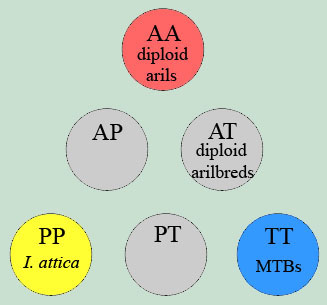
There are six possible diploid configurations: AA, AP, AT, PP, PT, and TT. Many of the iris species found in nature are diploid.
type: aril expected fertility:
fertile plants in cultivation:
some These are the diploid arils,
including all oncocyclus species and pure oncocyclus hybrids
(OH), as well as the Regelia species, with the exception of
Ii. hoogiana and stolonifera. This is a
fertile family, although outcrossing to plants of other
configuration is unlikely to produce fertile seedlings.
Because I. korolkowii is the regelia most used in
crossing with oncocycli, most RCs and OGs belong to this
group. These are undoubtedly among the most beautiful of all
irises. Unfortunately, they are also the most difficult to
grow and propagate outside their native climate (mountains
and deserts of the Middle East and central Asia). Hundreds
of garden varieties have been produced since the late 1800s,
but most are no longer in cultivation. Species: all oncocyclus species,
Ii. afghanica, darwasica, korolkowii,
lineata. Some garden varieties: Artemis,
Babylonian Brass, Charon, Gamaliel's Wisdom, Heritage
Orange, Judean Charmer, Kashmir Princess, Leo's Magic,
Polished Brass, Purple Sequin, Shalah, Teucros, Tirat
Tsvi.
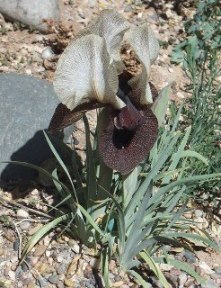
type: arilbred dwarf expected fertility:
infertile plants in cultivation:
none
This is the configuration one would expect to result from
crossing diploid arils with I. attica or I. pseudopumila.
Although it seems likely that someone would have tried such a
cross at some point, there are no registered irises in this group.
Any irises from such a cross would be expected to be infertile,
barring a chance unreduced gamete.
type: arilbred expected fertility:
infertile plants in cultivation:
few This configuration results from
crossing diploid arils with diploid TBs, MTBs, or
24-chromosome dwarf species such as I. suaveolens.
Many of the first arilbreds fall in this category,
including the famous 'William Mohr' and early varieties from
C. G. White such as 'Oyez', 'Nelson of Hilly', and 'Myomy'.
Most irises in this group are infertile or effectively so,
and arilbred breeding in the first half of the 20th century
was greatly frustrated by this fact. Few of these irises
remain in cultivation today, having been superseded by the
fertile amphidiploid arilbreds from C. G. White's later
work. Lowell Baumunk's 'Hammurabi' is a modern example of
this type.
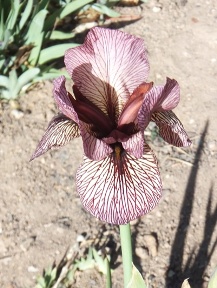
type: miniature dwarf
bearded expected fertility:
fertile plants in cultivation:
few This category is represented by two
dwarf bearded species, Ii. attica and
psedopumila. As far as I am aware, there are no
registered hybrids between these species and only a couple
clones have been named.

type: dwarf or median
bearded expected fertility:
infertile plants in cultivation:
none
This configuration would result from crossing I. attica
or I. pseudopumila with an MTB, diploid TB, or one of the
TT species. As far as I know, no plants of this sort have been
registered and introduced into commerce.
type: miniature tall
bearded expected fertility:
fertile plants in cultivation:
many Species: Ii. albertii, imbricata,
pallida, perrieri, reichenbachii (some clones),
scariosa, suaveolens, taochia, timofejewii,
variegata. Some garden varieties: Aachen Elf,
Bangles, Bumblebee Delite, Chickee, Foursome, Kaleidescope,
Mme. Chereau, Petite Monet, Quirk, Spring Thing, Welch's
Reward, White Canary, Zebra, Zula
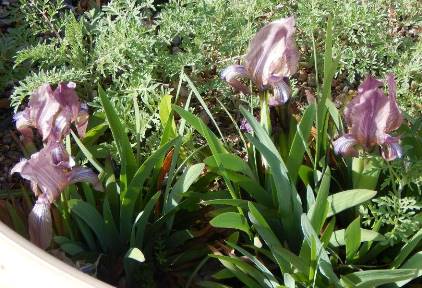
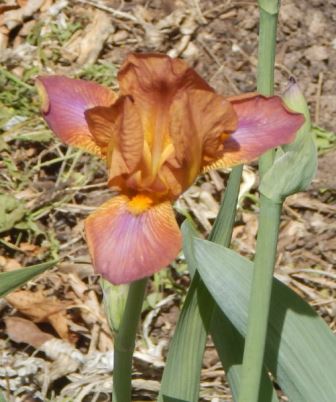 This
group includes most modern MTBs, as well as many antique TBs
from the early 20th century and earlier. Recently, MTB
breeders have been exploring the use of some of the lesser
known TT species. This group is a fertile family but,
being diploid, is unlikely to produce fertile offspring when
outcrossed with irises of other groups.
This
group includes most modern MTBs, as well as many antique TBs
from the early 20th century and earlier. Recently, MTB
breeders have been exploring the use of some of the lesser
known TT species. This group is a fertile family but,
being diploid, is unlikely to produce fertile offspring when
outcrossed with irises of other groups.
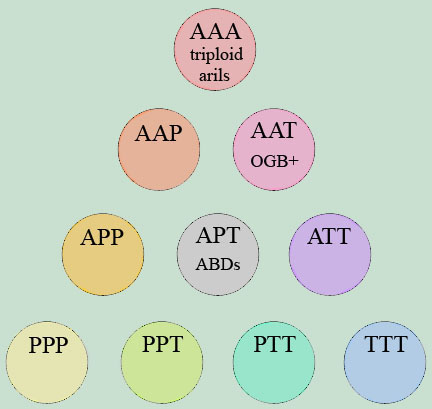
There are ten possible chromosome configurations at the triploid level: AAA, AAP, AAT, APP, APT, ATT, PPP, PPT, PTT, and TTT. None of these constitute a fertile family, nor are any triploid species found in nature. These plants are thus all the result of wide crosses made by hybridizers.
type: aril expected fertility:
limited plants in cultivation:
few
Triploid arils are produced by crossing diploid arils with
tetraploid arils. Some of the seedlings show some degree of
fertility, and the use of triploid arils is one way to expand the
fertile family of tetraploid arils. Most of these are RCs from I.
stolonifera or I. hoogiana, although OGs are also
represented in this group. As with all pure arils, gardenability is
an issue.
Some garden varieties: Aaron's Shield, Clara, Garnet Tiara, Guinevere, Hera, Lucia, Midnight Journey, Persian Violet.
type: arilbred dwarf expected fertility:
limited plants in cultivation:
none
Plants with this configuration would result from crossing
tetraploid arils with I. attica or I. pseudopumila.
Crossing amphidiploid arilpums with diploid arils would also give
this result. As far as I know, none have been produced by either
method. They might be helpful in expanding the amphidiploid
AAPP family with diverse aril genes.
type: arilbred expected fertility:
limited plants in cultivation:
some Many arilbreds of this type have
been produced by crossing amphidiploid arilbreds with
diploid arils. This type of cross is usually made to
introduce additional desirable aril characteristics into the
arilbreds. Most of the OGB+ "three-quarter-breds" are of
this type. This configuration would also result from
crossing MTBs or diploid TB or TT species with
tetraploid arils, although I am not aware of any having been
produced in this way. Irises of this group sometimes have
enough fertility to be bred back to either parental
type. Some garden varieties: Abu
Zabad, Bib Black Bumblebee, Ech-Chams Harra, Emerald
Fantasy, Izonya, Jeweled Veil, Jordanian Prince, Judean
Rouge, Kasbah Queen, Mendocino, Nitzan, Petite Sirrah,
Radiant Smile.
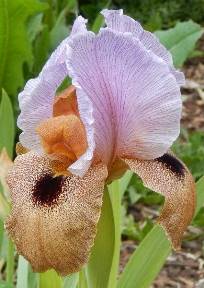
type: arilbred dwarf expected fertility:
limited plants in cultivation:
few Jonnye Rich produced three irises of
this type by crossing I. pumila with diploid arils.
The plants are MDB size and show some aril characteristics.
It would also be possible to produce irises of this type by
crossing I. attica or I. pseudopumila with
amphidiploid arilpums. The irises in this group are Pearls
on Onyx, Tiny Pirate, and Tiny Tyke.
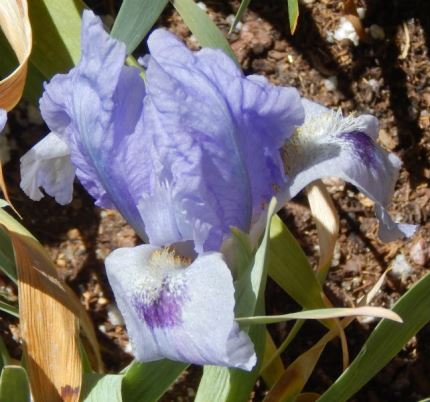
type: arilbred dwarf expected fertility:
infertile plants in cultivation:
few A number of arilbred dwarfs have
been produced by crossing SDBs with diploid arils. In
principle, the same configuration could be obtained by
crossing an amphidiploid arilbred with I. attica / I.
pseudopumila or by crossing an amphidiploid arilpum with
a diploid MTB. These plants tend to be SDB sized, with some
aril characteristics. Some garden varieties: Calypso
Clown, Canasta, Kelita Adah, Loudmouth, Omar's Eye, Plum
Cute.

type: arilbred expected fertility:
limited plants in cultivation:
few
Irises of this type can result from diploid arils crossed with
tetraploid tall beardeds or from amphidiploid arilbreds crossed with
MTBs or other diploids. (The first type is more common.) Most of
these were produced in the first half of the 20th century, and few
are still in cultivation.
Some garden varieties: Blumohr, Etching, Miss Martha, Sigrid.
PPP
type: miniature dwarf
bearded expected fertility:
limited plants in cultivation:
none
Irises of this type would result from crossing I. pumila with
I. attica or I. pseudopumila. I do not believe there
are any in cultivation.
type: miniature or standard dwarf
bearded expected fertility:
limited plants in cultivation:
none
Plants of this configuration would be produced by crossing I.
pumila with MTBs or other diploids, or by crossing SDBs with
I. attica / I. pseudopumila. Nes's 'Cap Sounion' (1959) was
produced from the latter type of cross. I do not believe any are
in cultivation.
type: intermediate
bearded expected fertility:
limited plants in cultivation:
few?
These are the result of SDB x MTB crosses, and could also be
produced by crossing tetraploid TBs, BBs, or MTBs with I. attica /
I. pseudopumila. I believe the first type of cross has been
made by MTB breeders, but I do not know of registered varieties from
such breeding. A few of the latter type have been registered over the
decades or used in further breeding.
type: tall or miniature tall
bearded expected fertility:
limited plants in cultivation:
few Triploid TBs were produced in the
early 20th century when tetraploid TBs became available and
were bred with the existing diploids. More recently, some
MTB breeders have crossed diploid MTBs with tetraploids from
I. aphylla breeding. The former group is probably
largely gone from gardens. Among the MTBs, it is often
difficult to distinguish diploids, triploids, and
tetraploids where the pedigree is complex. Some possible MTB triploids: Ozark
Dream, Ozark Maid Some antique triploid TBs: Queen
Caterina, San Gabriel, Frieda Mohr, Sunmist, Venus de
Milo.
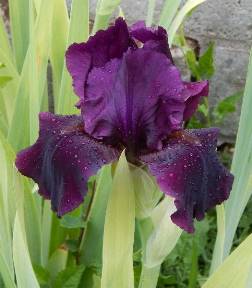
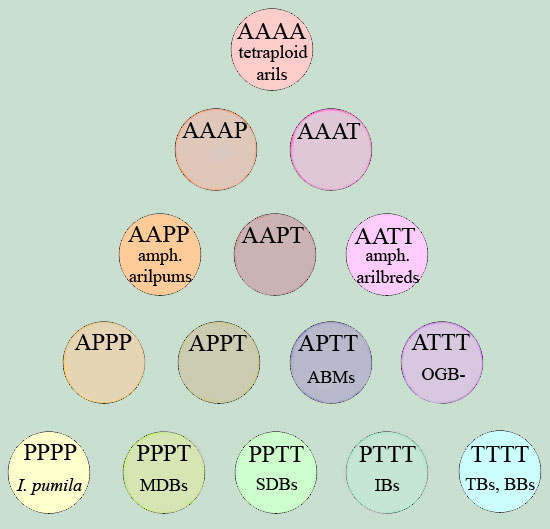
There are fifteen possible chromosome configurations at the tetraploid level: AAAA, AAAP, AAAT, AAPP, AAPT, AATT, APPP, APPT, APTT, ATTT, PPPP, PPPT, PPTT, PTTT, and TTTT. These include six fertile families (the tetraploid arils, TBs, and I. pumila; and the amphidiploid SDBs, arilbreds, and arilpums). The nine remaining combinations are expected to have limited fertility, as they are unbalanced tetraploids with two sets that pair and two that do not.
type: aril expected fertility:
fertile plants in cultivation:
few

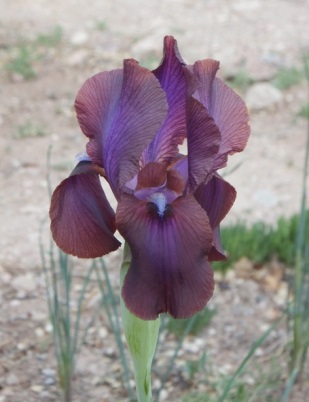 For
more on this group, see my Tetraploid
Arils page.
For
more on this group, see my Tetraploid
Arils page.
type: arilbred expected fertility:
limited plants in cultivation:
few
This is the configuration that results when an amphidiploid arilpum
is crossed with a tetraploid aril. Elm Jensen has registered two such
irises: 'Kazakhstan' and 'Moments Later', both from a
stolonifera/pumila seedling as the arilpum parent.
type: arilbred expected fertility:
limited plants in cultivation:
few
Irises of this type are produced when amphidiploid arilbreds are
crossed with tetraploid arils. Earlier examples typically used I.
hoogiana or I. stolonifera as the aril parent, and more
recently Sharon McAllister has produced a number of irises of this
type using tetraploid RCs. This group includes fewer irises than the
triploid "3/4-breds" with diploids as the aril parent, and regelia
characteristics are often prominent.
Some garden varieties: Armenian Descent, Bedouin Child, Celeste Azul, Code Talker, Inscrutable, Persian Art, Rebecca's Veil, Sky Signal, Urmia.
type: arilbred dwarf expected fertility:
fertile plants in cultivation:
few For more on this group, see my
Arilpums
page.
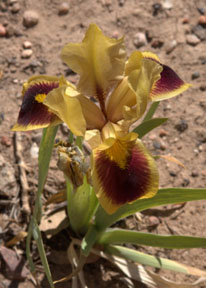
type: arilbred median expected fertility:
limited plants in cultivation:
few Plants of this configuration can be
produced by crossing amphidiploid arilpums and arilbreds
together, or by crossing tetraploid arils with SDBs. All
known varieties are from the latter type of cross. Early
breeders crossed garden dwarf bearded irises with regelia
species; some more recent introductions make use of
tetraploid RCs. The historic 'Zwanenburg'
possibly belongs to this group, apparently the result of an
unreduced gamete from its diploid aril parent, I.
susiana. Known garden
varieties: Bakhshish, Benjamin, Black Dazzler, High
Sierra Snow, Lilli-Hoog, New Era, Party Robe, Ray Serene,
Spotless, Spring Caper, Vera-Anne, Vera-Beatrice,
Vera-Louise, Vera-Marina, Vera-Olivia, Vera-Ruby.
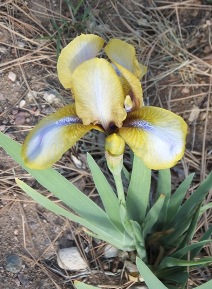
type: arilbred expected fertility:
fertile plants in cultivation:
many
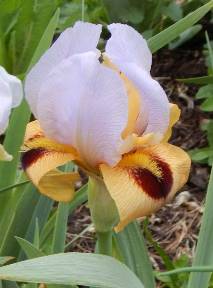
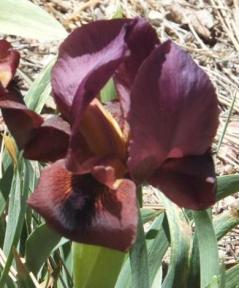 For
more on this group, see my Amphidiploid
Arilbreds page.
For
more on this group, see my Amphidiploid
Arilbreds page.
type: arilbred dwarf expected fertility:
limited plants in cultivation:
none
Plants of this sort would be obtained by crossing amphidiploid
arilpums with I. pumila. Werckmeister's 'Nunatakr' and
'Plusia' (and possibly Miller's 'Bite Size' and 'Snuggles') are the
only examples I know of.
type: arilbred dwarf or
median expected fertility:
limited plants in cultivation:
few Irises in this group result either
from crossing I. pumila with an amphidiploid
arilbred, or crossing an arilpum with an SDB ('Persian
Sapphire' being the only one from this latter type of
cross). Known garden varieties: Baby
Kabul, Bozrah, Persian Sapphire, Saletta, Wine
Sundae.
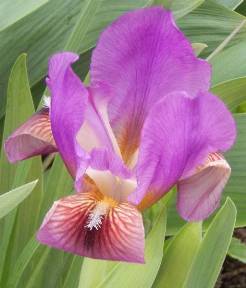
type: arilbred median expected fertility:
limited plants in cultivation:
some Some garden varieties: Byzantine
Beauty, Cairo Love Song, Chain Reaction, Earfalas, Eye to
Eye, Fairy Goblin, Jewel of Omar, Little Orchid Annie,
Octave, Prairie Thunder, Prince of Egypt, Sajjetta,
Suspect.
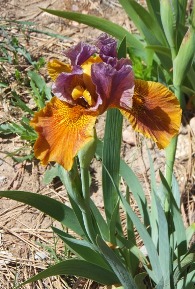
 Most
arilbred medians are the result of crossing SDBs with
amphidiploid arilbreds. In principle, plants of this type
could also be produced by crossing amphidiploid arilpums
with TBs, although none of the latter are known to date.
These irises are some of the most popular arilbreds of less
than half aril content, and frequently win high awards in
this category.
Most
arilbred medians are the result of crossing SDBs with
amphidiploid arilbreds. In principle, plants of this type
could also be produced by crossing amphidiploid arilpums
with TBs, although none of the latter are known to date.
These irises are some of the most popular arilbreds of less
than half aril content, and frequently win high awards in
this category.
type: arilbred expected fertility:
limited plants in cultivation:
some Some garden varieties: Cope Goodwin,
Coronation Tapestry, Desert Festival, Dune, Elmohr,
Engraved, Gentle Poet, Hakuna Matata, Moonchild,
Old-Fashioned Girl, Saffron Jewel, World Wide
Web.
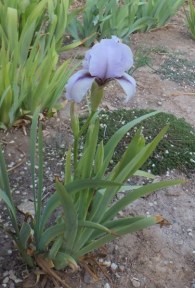
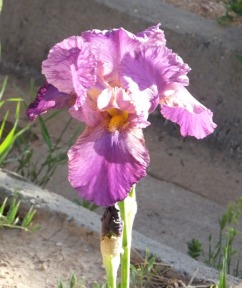 These
are the quarterbreds or "Mohr type" arilbreds from crossing
amphidiploid arilbreds with TBs. These were popular in the
mid-20th century, as they are easy-to-grow plants that show
some aril characteristics. Interest in the group has
declined somewhat, after improvements in the amphidiploid
arilbreds made that group an often better choice for those
interested in arilbreds. A number are still being produced,
however, and many are attractive garden subjects.
These
are the quarterbreds or "Mohr type" arilbreds from crossing
amphidiploid arilbreds with TBs. These were popular in the
mid-20th century, as they are easy-to-grow plants that show
some aril characteristics. Interest in the group has
declined somewhat, after improvements in the amphidiploid
arilbreds made that group an often better choice for those
interested in arilbreds. A number are still being produced,
however, and many are attractive garden subjects.
type: miniature dwarf
bearded expected fertility:
fertile plants in cultivation:
few
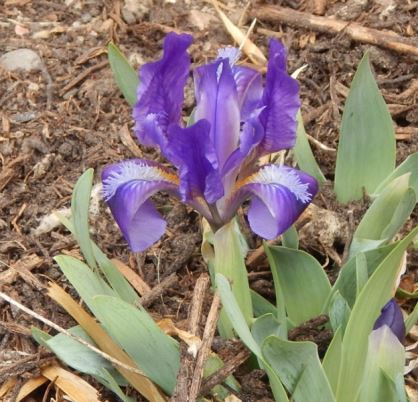
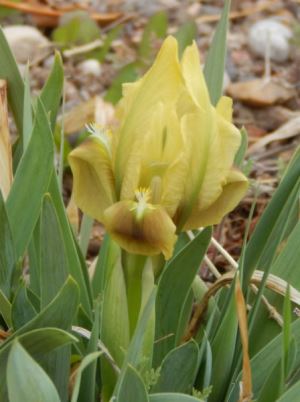 For
more on this group, see my Iris
pumila
page.
For
more on this group, see my Iris
pumila
page.
type: miniature dwarf
bearded expected fertility:
limited plants in cultivation:
some Some garden varieties: Alpine Lake,
April Ballet, Azurea, Cradle Blue, Fuzzy, Gobo, Gold Canary,
Little Rascal, Nuggets, Pixie Pirate, Robin's Egg, Saucy
Sprite, Scruples, Secret Eye, Toyland.

 The
classic cross for modern MDBs is SDB x pumila, which
produces irises in this group (although there are smattering
of pure pumila MDBs and many from SDB breeding as well).
This group shows somewhat more fertility than one might
expect, and breeding with other MDBs is not
uncommon.
The
classic cross for modern MDBs is SDB x pumila, which
produces irises in this group (although there are smattering
of pure pumila MDBs and many from SDB breeding as well).
This group shows somewhat more fertility than one might
expect, and breeding with other MDBs is not
uncommon.
type: standard dwarf
bearded expected fertility:
fertile plants in cultivation:
many
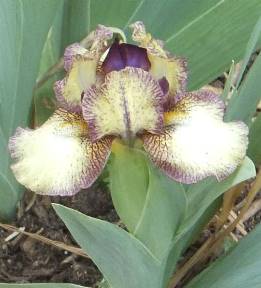
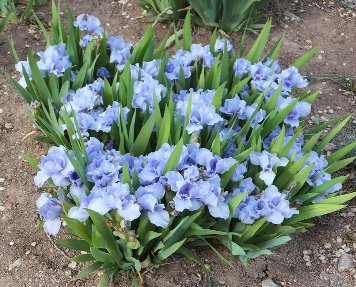 For
more on this group, see my Amphidiploid
Dwarf and Median
page.
For
more on this group, see my Amphidiploid
Dwarf and Median
page.
type: intermediate
bearded expected fertility:
limited plants in cultivation:
many Some garden varieties: April Fog,
Attitude, Azure Echo, Broadway Baby, Confederate Soldier,
Gaslight, Honey Glazed, Hot Fudge, Lemon Pop, Rare Edition,
Shampoo, Silent Strings, Voila.
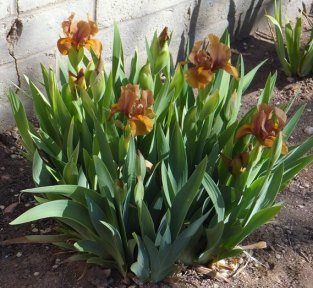
 The
classic cross for IBs, TB x SDB, produces irises of
this type. A few have some fertility, but most breeding has
focused on making making the TB x SDB cross with select
parents. These are important garden plants, bridging the
dwarf and tall bearded bloom seasons. The species I.
albicans, presumably a natural hybrid of ancient origin,
has this configuration as well.
The
classic cross for IBs, TB x SDB, produces irises of
this type. A few have some fertility, but most breeding has
focused on making making the TB x SDB cross with select
parents. These are important garden plants, bridging the
dwarf and tall bearded bloom seasons. The species I.
albicans, presumably a natural hybrid of ancient origin,
has this configuration as well.
type: tall bearded and border
bearded expected
fertility:
fertile plants in cultivation:
many
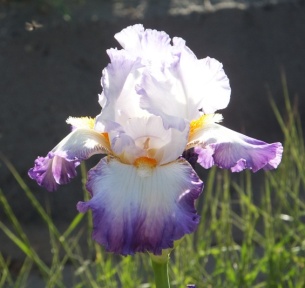
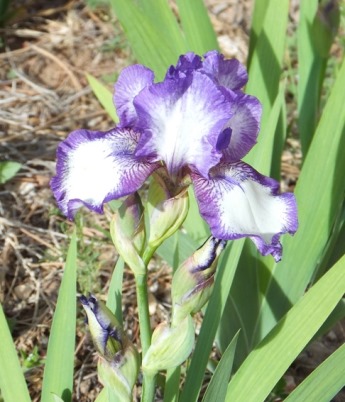 For
more on this group, see my page on The
48-Chromosome Bearded Irises.
For
more on this group, see my page on The
48-Chromosome Bearded Irises.
So what can be learned from an overview such as this? One simple observation is that some of these groups are much more developed than others. The reasons for this are many: available species, historical accident, gardenability, and popularity trends. It is unlikely that we will ever see hundreds of garden varieties of the PP diploid group (Ii. attica and pseudopumila), for example: There are not many different species to work with, and I. pumila is more varied and more useful in outcrossing to other types. In other cases, however, there would seem to be quite a lot of untapped potential for adventurous breeders to dip into.
A second observation is that development of the fertile families seems to drive the improvement of the garden irises. All our irises are either members of these families or rely on them for parental stock. The IBs could not have improved as much as they have over the decades, for example, were it not for improvements in the fertile families of SDBs and TBs. Modern OGB+ "3/4-breds" and arilbred medians would not exist as we know them if the fertile family of amphidiploid arilbreds had not reached a critical mass to allow ongoing improvement through breeding.
Triploids, although limited in their fertility, provide about the only way for the ordinary hybridizer to bring genes from diploid irises into the tetraploid fertile families. (The other option being to hope for an unreduced diploid gamete to appear by chance.) This is particularly important in the case of the arils, since all oncocyclus species are diploids. Unbalanced tetraploids are of less usefulness in expanding the gene pool, since their parental stock are members of the tetraploid fertile families already.
We can imagine a future when the genes from all the many delightful and beautiful species of aril and bearded irises are preserved in our garden plants, to be brought together in any imagined combination for long-term breeding projects. This future can be largely realized among the tetraploids, if the fertile families are sufficiently varied and inclusive. The PPPP family is self-contained and is not likely to expand in its gene pool. The TTTT family is expanding gradually, thanks to breeders working with I. aphylla and more recently other species in this group. Where the most work is needed, though, is in expanding the tetraploid arils with genes from the diploid oncocycli. This is probably the only way to keep the full genetic legacy of the oncocycli alive for the long-term breeding of garden irises.
September 2010
updated April 2018
|
|
Unless otherwise noted, all text and illustrations copyright Tom Waters and all photographs copyright Tom or Karen Waters. Please do not reproduce without permission.